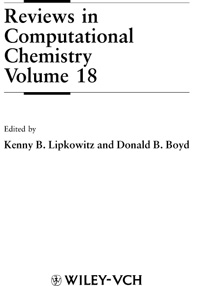Reviews in Computational Chemistry. V. 18
| Автор(ы): | Lipkowitz K. B., Boyd D. B.
06.10.2007
|
| Год изд.: | 2002 |
| Описание: | Topics in a number of important areas of computational chemistry are the substance of this volume. Chapter 1 of this volume is a tutorial on clustering methods. Chapter 2 summarizes what has been learned about scoring functions and gives an example of how they have been applied to find new ligands in databases of real and/or conceivable (virtual) molecular structures stored on computers. In Chapter 3, Professors Steven W. Rick and Steven J. Stuart scrutinize the methods that have been devised to account for polarization. In Chapter 4, Professors Dmitry V. Matyushov and Gregory A. Voth present a rigorous frontier report on the theory and computational methodologies for describing charge-transfer and electron-transfer reactions that can take place in condensed phases. In Chapter 5, Dr. George R. Famini and Professor Leland Y. Wilson teach about linear free energy relationships (LFERs) using molecular descriptors derived from—or adjuncts to—quantum chemical calculations. In Chapter 6, Professor Dr. Sigrid D. Peyerimhoff masterfully traces the history of computational chemistry in Germany. This chapter complements the historical accounts covering the United States, Britain, France, and Canada, which were covered in prior volumes of this book series. Finally, as a bonus with this volume, editors present a perspective on the employment situation for computational chemists. The essay in the appendix reviews the history of the job market, uncovers factors that have affected it positively or negatively, and discusses the current situation. |
| Оглавление: |
 Обложка книги.
Обложка книги.
Geoff M. Downs and John M. Barnard Introduction [1] Clustering Algorithms [6] Hierarchical Methods [6] Nonhierarchical Methods [9] Progress in Clustering Methodology [14] Algorithm Developments [14] Comparative Studies on Chemical Data Sets [23] How Many Clusters? [24] Chemical Applications [28] Conclusions [33] References [34] 2. The Use of Scoring Functions in Drug Discovery Applications [41] Hans-Joachim Bohm and Martin Stahl Introduction [41] The Process of Virtual Screening [43] Major Contributions to Protein-Ligand Interactions [45] Description of Scoring Functions for Receptor-Ligand Interactions [49] Force Field-Based Methods [51] Empirical Scoring Functions [53] Knowledge-Based Methods [56] Critical Assessment of Current Scoring Functions [58] Influence of the Training Data [58] Molecular Size [59] Other Penalty Terms [59] Specific Attractive Interactions [60] Water Structure and Protonation State [61] Performance in Structure Prediction [61] Rank Ordering Sets of Related Ligands [63] Application of Scoring Functions in Virtual Screening [63] Seeding Experiments [64] Hydrogen Bonding versus Hydrophobic Interactions [65] Finding Weak Inhibitors [69] Consensus Scoring [70] Successful Identification of Novel Leads through Virtual Screening [72] Outlook [75] Acknowledgments [76] References [76] 3. Potentials and Algorithms for Incorporating Polarizability in Computer Simulations [89] Steven W. Rick and Steven J. Stuart Introduction [89] Nonpolarizable Models [90] Polarizable Point Dipoles [91] Shell Models [99] Electronegativity Equalization Models [106] Semiempirical Models [116] Applications [120] Water [120] Proteins and Nucleic Acids [125] Comparison of the Polarization Models [127] Mechanical Polarization [127] Computational Efficiency [129] Hyperpolarizability [130] Charge-Transfer Effects [131] The Electrostatic Potential [132] Summary and Conclusions [133] References [134] 4. New Developments in the Theoretical Description of Charge-Transfer Reactions in Condensed Phases [147] Dmitry V. Matyushov and Gregory A. Voth Introduction [147] Paradigm of Free Energy Surfaces [155] Formulation [156] Two-State Model [160] Heterogeneous Discharge [165] Beyond the Parabolas [167] Bilinear Coupling Model [169] Electron Transfer in Polarizable Donor-Acceptor Complexes [175] Nonlinear Solvation Effects [182] Electron-Delocalization Effects [184] Nonlinear Solvation versus Intramolecular Effects [190] Optical Band Shape [191] Optical Franck-Condon Factors [192] Absorption Intensity and Radiative Rates [195] Electron-Transfer Matrix Element [197] Electronically Delocalized Chromophores [198] Polarizable Chromophores [201] Hybrid Model [202] Summary [205] Acknowledgments [206] References [206] 5. Linear Free Energy Relationships Using Quantum Mechanical Descriptors [211] George R. Famini and Leland Y. Wilson Introduction [211] LFER Methodology [212] Background [214] Computational Methods [214] Linear Free Energy Relationships [215] Descriptors [218] Classifications [218] Quantum Mechanical Descriptors [219] Quantum Mechanical Calculations [220] Statistical Procedures [227] Multiple Regression Analysis [227] Examples of LFER Equations [231] Model-Based Methods [232] Nonmodel-Based Methods [246] Conclusions [250] References [251] 6. The Development of Computational Chemistry in Germany [257] Sigrid D. Peyerimhoff Introduction [257] Computer Development [260] The ZUSE Computers [260] The G1, G2, and G3 of Billing in Gottingen [261] Computer Development at Universities [263] The Analog Computer in Chemistry [264] Quantum Chemistry, A New Start [264] Theoretical Chemistry 1960-1970 [267] The Deutsche Rechenzentrum at Darmstadt [268] Formation of Theoretical Chemistry Groups [269] Deutsche Forschungsgemeinschaft-Schwerpunktprogramm Theoretische Chemie [271] Theoretical Chemistry Symposia [273] Scientific Developments [274] Computational Chemistry 1970-1980 [276] European Efforts [278] Computer-Aided Synthesis [278] Progress in Quantum Chemical Methods [279] Beyond 1980 [282] Acknowledgments [285] References [285] Appendix. Examination of the Employment Environment for Computational Chemistry [293] Donald B. Boyd and Kenny B. Lipkowitz Introduction [293] Hiring Trends [294] Skills in Demand [303] The Broader Context [310] Salaries [314] Conclusions [317] Acknowledgments [317] References [317] Author Index [321] Subject Index [337] |
| Формат: | djvu |
| Размер: | 2144640 байт |
| Язык: | ENG |
| Рейтинг: |
305
|
| Открыть: | Ссылка (RU) |